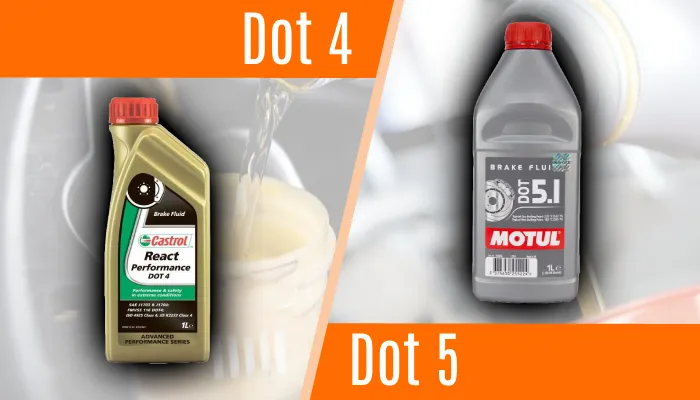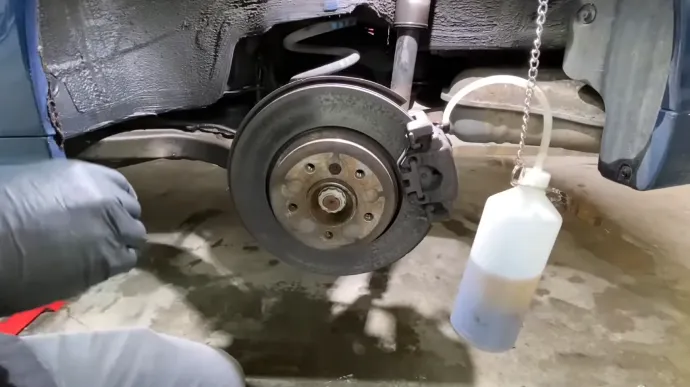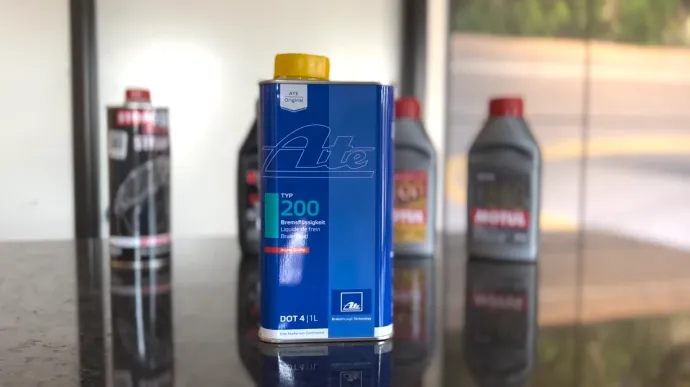Physical Address
304 North Cardinal St.
Dorchester Center, MA 02124
Physical Address
304 North Cardinal St.
Dorchester Center, MA 02124

Brake fluid transmits force from the brake pedal to the brake components in any vehicle’s hydraulic braking system. Two common types of brake fluid used in this system are DOT 4 and DOT 5. While they serve the same fundamental purpose, these brake fluids significantly differ in composition and compatibility.
DOT 4 brake fluid is glycol-based and suitable for most standard brake systems, including ABS. However, DOT 5 brake fluid is silicone-based and preferred for specialized applications but is not typically compatible with standard brake systems or with ABS.
The purpose of this article is to discuss the major differences between DOT 4 and DOT 5 brake oil grades. So keep reading for detailed information.

Let’s explore the key differences between DOT4 and DOT5 oil grades for brake fluid.
To understand the differences between the composition of DOT 4 and DOT 5 grades for brake fluid, you need to know their distinct properties and ingredients.
DOT 4 brake oil is glycol-based and contains a mixture of glycols, borate esters, and other additives. These components provide DOT 4 with excellent anti-corrosion properties and low viscosity, making it suitable for most standard brake systems.
Alternatively, DOT 5 brake oil is silicone-based, featuring silicone polymers as its primary ingredient. This composition offers increased resistance to moisture absorption, making it a preferred choice for specialized applications.
DOT 4 brake fluid is hygroscopic, which tends to absorb atmospheric moisture over time. This moisture absorption can lead to a reduction in its boiling point and can cause degradation of the brake system.
On the other hand, DOT 5 fluid is hydrophobic, which means it repels water and doesn’t absorb moisture. This hydrophobic property allows DOT 5 brake fluid to maintain a stable boiling point and resist performance degradation caused by moisture.
Understanding the boiling points of these two oil grades is essential because it directly affects the performance and safety of your braking system. DOT 4 brake fluid has a dry boiling point of around 230°C (446°F) and a wet boiling point of approximately 155°C (311°F).
Conversely, DOT 5 brake fluid boasts a higher dry boiling point of around 260°C (500°F) and a wet boiling point of roughly 180°C (356°F). These higher boiling points make DOT 5 brake fluid more suitable for extreme temperatures and high-performance conditions.
DOT 4 brake fluid is compatible with most standard braking systems, including anti-lock braking systems (ABS). This makes it a suitable choice for passenger vehicles. However, DOT 4 brake fluid isn’t typically compatible with silicone-based DOT 5 brake fluid.
On the other hand, DOT 5 brake fluid is less compatible with standard brake systems and shouldn’t be used in vehicles with ABS. Mixing DOT 5 with glycol-based brake fluids like DOT 3 or DOT 4 can lead to system malfunctions.
To understand the differences in vehicle applications between DOT 4 and 5 brake fluid grades, consider their specific properties and how they impact performance and safety.
DOT 4 brake fluid is widely used in various vehicles, such as passenger cars, trucks, and motorcycles, and is suitable for everyday driving conditions. It provides excellent performance and meets the requirements of most vehicles on the road.
On the other hand, DOT5 brake fluid isn’t as versatile and is typically used in specialized applications. It’s often specified for high-performance vehicles, certain military vehicles.

DOT 4 brake fluid is typically clear to amber in color, allowing easy visual identification. This is particularly useful when checking the fluid level in the master cylinder.
As opposed to this, DOT 5 brake fluid is usually purple in color. This distinct color serves as a visual marker, helping to prevent accidental mixing with glycol-based fluids. By having a different color, DOT 5 brake fluid ensures that it’s easily distinguishable from other types of brake fluids.
When comparing DOT 4 and DOT 5 brake fluid grades, you’ll notice a significant difference in compressibility. DOT 4 brake fluid, being less compressible, can transmit hydraulic pressure more efficiently. This results in a more responsive braking experience with a firm, solid pedal feel.
Then again, DOT5 brake fluid is more compressible than DOT 4 glycol-based fluids. This characteristic leads to a slightly softer pedal feel. While some drivers may prefer the softer pedal feel of DOT 5 fluid, it’s worth considering the trade-off in terms of responsiveness.
The more compressible nature of DOT 5 fluid may result in a slightly longer pedal travel and a potentially delayed response in braking.
DOT 4 brake fluid, once opened, has a relatively short shelf life of around one year. After this period, it may start to absorb moisture, leading to a decrease in its effectiveness.
However, DOT 5 brake fluid has a longer shelf life once the container is opened. It can last up to three years before significant moisture absorption occurs. This extended shelf life can be advantageous for vehicles that aren’t frequently used.
DOT 4, a glycol-based brake fluid, is more forgiving when handling and spillage. It’s less likely to cause damage to vehicle paint or surfaces in the event of a spill.
On the other hand, DOT 5, which is silicone-based, can be more challenging to handle. It tends to damage paint and surfaces, making care and precaution necessary during maintenance.
Regarding cost, DOT 4 brake fluid offers a more budget-friendly option than DOT 5. This affordability is particularly beneficial for routine maintenance, where cost-effectiveness is a significant consideration.
In contrast, DOT 5 brake fluid tends to be pricier than glycol-based alternatives. The higher cost can be attributed to the specialized nature of DOT 5, which offers advantages in terms of longevity and performance.
Here’s a comparison table highlighting the major differences between DOT4 and DOT5 brake fluids:
| Characteristic | DOT 4 Brake Fluid | DOT 5 Brake Fluid |
| Composition | Glycol-based | Silicone-based |
| Hygroscopic vs. Hydrophobic | Hygroscopic (Absorbs moisture) | Hydrophobic (Repels moisture) |
| Boiling Points (Dry/Wet) | Dry: ~230°C (446°F) / Wet: ~155°C (311°F) | Dry: ~260°C (500°F) / Wet: ~180°C (356°F) |
| Compatibility with ABS | Generally compatible with ABS systems | Not compatible with ABS systems |
| Vehicle Applications | Used in a wide range of vehicles including passenger cars, trucks, and motorcycles | Typically used in specialized applications and certain high-performance vehicles |
| Color | Clear to amber | Purple |
| Compressibility | Less compressible, resulting in a firmer pedal feel | More compressible, resulting in a slightly softer pedal feel |
| Shelf Life (Once Opened) | Short, about 1-year | Longer, up to 3 years |
| Handling Requirements | Less likely to damage paint or surfaces | Requires more care to avoid damage to paint and surfaces |
| Cost | Generally more cost-effective | Typically more expensive due to performance advantages |

DOT 4 brake fluid is specifically formulated for use in conventional hydraulic brake systems, where DOT 4 fluids are recommended. It’s a high-performance, non-petroleum automotive brake fluid with superior performance and reliability.
DOT 4 brake fluid has a higher boiling point than DOT 3 fluid, making it suitable for vehicles that experience high operating temperatures, such as towing or passenger cars. This brake fluid is designed to provide excellent braking performance, ensuring efficient and consistent braking.
When comparing DOT 5 and DOT 4 brake fluids, you’ll find that DOT 5 has distinct advantages. One of the main advantages is its higher boiling point.
With a dry boiling point of 260°C and a wet boiling point of 180°C, DOT 5 can withstand higher temperatures than DOT 4. This means that DOT 5 brake fluid is less likely to boil and vaporize under extreme conditions, such as during heavy braking or in hot climates.
Also, DOT 5 is silicone-based, making it more rust and corrosion-resistant. This can lead to a longer fluid life and better overall performance. However, DOT 5 isn’t compatible with most ABS systems, so check the vehicle’s specifications before using it.
To determine the appropriate usage of DOT 5 brake fluid, consider its specific advantages and limitations about the vehicle’s requirements and compatibility with braking systems.
DOT 5 brake fluid is best suited for high-grade military vehicles that operate under extreme conditions. Its fully synthetic silicone-based formula ensures it remains stable and doesn’t absorb moisture over time. This characteristic makes it ideal for vehicles exposed to high temperatures or experience heavy braking.
However, remember that DOT 5 isn’t compatible with microvalve ABS systems. Therefore, verify the compatibility of the brake fluid with the vehicle’s ABS before using DOT 5.
The choice between DOT 4 and DOT 5 brake fluid should be based on the specific requirements of your vehicle and its braking system.
While DOT 4 is versatile, cost-effective, and suitable for most everyday driving conditions, DOT 5 excels in resisting moisture absorption and maintaining high boiling points, making it ideal for specialized applications.
One interesting statistic is that DOT 4 brake fluid is used in approximately 90% of modern vehicles, highlighting its widespread popularity and effectiveness. So, check your vehicle’s manufacturer recommendations before choosing brake fluid and make sure it’s compatible.